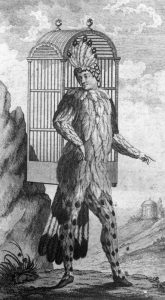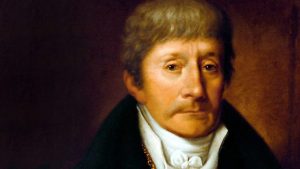It was on September 30, 1791 – 228 years ago today – that Wolfgang Mozart’s opera-slash-singspiel, The Magic Flute, received its premiere at the Freihaustheater auf der Wieden in Vienna, conducted by Mozart himself.

In terms of its story arc, The Magic Flute is a mess. Like a Hollywood screenplay re-written by one (or two or three) too many writers, its libretto is all over the place, all of the time, projecting five parallel simultaneous storylines.
Storyline number one
The Magic Flute is a fairytale farce, featuring dancing animals, dragons, a bird-man and a bird-lady, an evil queen, a noble brotherhood of priests, a clownish Blackamoor, and your basic stock-in-trade prince and princess.
Storyline number two
The Magic Flute is a love story about successful and unsuccessful couplings. On one hand, the prince ends up with the princess, and the bird-man with the bird-lady. On the other hand, the minions of the evil queen hunger desperately for men but dine only on death; the Blackamoor lusts for the princess but eats only her dust.
Storyline number three
The Magic Flute is a “coming of age” story, one that traces the prince’s journey from post-adolescence to manhood, from a fainting wimp with no arrows in his quiver (literally) to a heroic, death-defying stud.

Storyline number four
The Magic Flute is a feminist tract. Yes. At its heart, it’s about the struggle between matriarchal and patriarchal worldviews. The opera’s essential protagonist – the Queen of the Night – is an old-world matriarch: a tough, savvy, professional woman who has hit the glass ceiling and is now enraged by her betrayal at the hands of men. Conversely, the Queen’s daughter, the Princess Pamina, is rewarded by those very same men for her bravery and purity and is made a priest in the society of men, presumably reconciling mankind and womankind. (Boy, does that ever tick off her mother, the Queen of the Night!)
Storyline number five
The Magic Flute is a depiction (for those cognoscenti “in the know”) of the Masonic rites of initiation, from the rituals of selection to enlightenment, a journey from darkness, fear and superstition (that is, from ignorance) to light, courage, and wisdom (that is, enlightenment).
If The Magic Flute is indeed such a confusing mish-mash of plot and insider information, why is it considered an epic masterwork? That’s an easy question to answer. Because Wolfgang Mozart wrote the music. Mozart’s music so elevates the genre of singspiel, breaths such life and depth and humanity into what are stock characters, renders so complex the interaction of those characters during ensembles and finales, and imbues the moments of ritual in the opera with such sublimity and majesty that the opera as a wholistic experience transcends entirely the weaknesses of its libretto.
(It’s one thing to create a great opera by composing great music to a great libretto, as Mozart did in his operas The Marriage of Figaro, Don Giovanni, and Così fan tutte, with libretti by the wonderful Lorenzo da Ponte. It’s another thing altogether to create a great opera by writing great music that elevates, completely, a klutzy libretto filled with cardboard characters, specious dramatic situations, and endless obscure Masonic references and at the same time make the piece appealing to the general public for whom it was written. The Magic Flute might very well be Mozart’s greatest masterwork, just because of the distance between its libretto and the final product, just because Mozart is able to make something so sublime out of what otherwise might have been a big, dumb, mess.)

The libretto was written by the actor, singer, dramatist and impresario Emanuel Schikaneder (1751-1812) who was, in 1791, the director of the Freihaustheater auf der Wieden.
Johann Josef Emanuel Schikaneder was born in Straubing, Germany, on September 1, 1751. Five years older than Mozart, he grew up in Regensburg, not far from Munich, where he went to the Jesuit Gymnasium and sang in the cathedral choir. His musical studies were augmented by training in dance and acting; beyond that, the details of his early life and adolescence are hard to come by. In 1773, at the age of 22, he joined a traveling theatrical troupe run by one F. J. Moser as an actor and a dancer; by 1777, Schikaneder was one of Moser’s leading actors. In December 1777 – at the age of 26 – Schikaneder got his big break: he appeared at the prestigious Munich Court Theater in a production of Hamlet performing the role of Hamlet, the great Dane himself. The performance was such a success that the final scene had to be encored. One month later – in January 1778 – banking off his success in Munich, Schikaneder founded his own acting troupe. Between 1778 and 1780, Schikaneder’s company appeared in, among other cities, Ulm, Stuttgart, Augsberg, Nuremburg, Rothenburg, Linz, and Klangenfurt. In September of 1780, the now 29-year-old Schikaneder and his company settled in for an extended season in the city of Salzburg, its repertoire split between spoken plays, Italian operas, and German-language singspiels. (For our information, a “singspiel” is a German-language opera in which – like American musical theater – there is a substantial amount of spoken dialogue.)
Living in Salzburg in the fall of 1780 was that city’s most famous and unhappiest son, Wolfgang Mozart, 24 years old. Mozart had crawled back to Salzburg, to his father and to the employ of Archbishop Hieronymus Colloredo just 20 months before, in January of 1779, after a disastrous residence in Paris, the death of his mother, and the rejection – by the soprano Aloysia Weber – of his proposal of marriage. By the fall of 1780, back in Salzburg, Mozart had come to hate what he perceived as the city’s provincialism and the Archbishop’s cretinism with a fervor that might well be called pathological.
During the months of September and October 1780, Wolfgang Mozart and Emanuel Schikaneder bonded and became great friends. Schikaneder’s company brought a welcome burst of theatrical life back to Salzburg, where the Archbishop had closed down most of the theatrical venues for what he deemed “moral cause”:
“Actors and actresses in costume, singing and prancing around a stage, displaying themselves in an ungodly manner to our people, a lewd and lascivious entertainment, promoting only vice and sin!”
For Mozart, the presence of Schikaneder and his company was manna from heaven, an opportunity to hang out with professional, touring performers: people like himself. And while we can’t know what Wolfgang (24 years old) and Emanuel (29 years old) talked about over their brandy and pipes, they must have fantasized about collaborating one day in a major venue, say, Vienna. Vienna: wouldn’t that be just grand?
The next nine years saw Schikaneder traveling across Germany and Austria with various theater and opera companies of his own creation. In 1787 he joined the Masonic Lodge in Regensburg, which in itself would be a trivial footnote except for the fact that The Magic Flute just happens to be “about” the initiation rites and rituals of Masonry. For our information: Schikaneder was most assuredly not a respectable Mason; he was kicked out of the Regensburg Lodge for doing something illicit with someone’s wife and/or daughter (perhaps even a standard poodle; we just don’t know). Theater people: hide your wife, lock up your daughters.
In July of 1789, Schikaneder took over the directorship of the Freihaustheater auf der Wieden, outside the city walls of Vienna. Settling down, he began to write the plays and opera and singspiel libretti that were to become the backbone of the theater’s repertoire for the next 12 years.
Sometime in early 1791, Schikaneder made Mozart – who had been living in Vienna since 1781 – an offer he couldn’t refuse. Schikaneder suggested that they collaborate on a popular show – a singspiel – to be produced at Schikaneder’s theater. Mozart had not written a major German-language opera since The Abduction from the Serail in 1782; he desperately wanted to write more German language opera, but the opportunity had not presented itself. Here, then, was the opportunity: Schikaneder’s theater was a public theater; its patrons were the middle and working classes, not the nobility and aristocracy Mozart had been composing for at the Imperial Opera Theater.
Desperate for the money and intrigued by the prospect of writing a singspiel for a public theater, Mozart accepted Schikaneder’s offer. With a bit of help from Mozart himself, Schikaneder cobbled together the libretto for The Magic Flute.
The Magic Flute premiered on September 30, 1791, 228 years ago today. It was immediately apparent that Mozart and Schikaneder had created a hit. Single-handedly, Mozart had raised the popular genre of German-language singspiel to a level of operatic art equal to that occupied by Italian-language opera. Mozart adored his creation, and went to the theater almost every night, where he enjoyed the audience’s reaction to Flute almost as much as the opera itself.
Thanks to The Magic Flute, by early October of 1791 Mozart’s compositional career and with it, his financial security – which had just been on the verge of implosion – were back on track. Even as The Magic Flute was the toast of Vienna, Mozart’s opera The Mercy of Titus was being acclaimed in Prague. On the evening of October 7th and 8th Mozart wrote his wife Constanze, who was “taking the cure” at the spa in nearby Baden:
“I’ve just come from [The Magic Flute]; it was just as full as ever . . . you really can see how this opera is steadily getting bigger and bigger . . . and the most remarkable thing is that on the evening when The Magic Flute was first performed to so much acclaim, on that very evening in Prague Titus was being presented and also to extraordinary applause.”

On October 13, two weeks after its premiere, Mozart took a group of friends and family to see it, including his mother-in-law, his 7-year-old son Karl, Antonio Salieri and Salieri’s mistress, Catarina Cavalieri. Salieri was knocked out by The Magic Flute, publicly stating that it was:
“Fit to be performed before the greatest monarchs at the greatest festivities.”
Mozart was thrilled by Kapellmeister Salieri’s compliment.
Tragically and ironically, at this moment of his popular rebirth, Mozart had just a few weeks to live. 38 days after taking Salieri to see The Magic Flute, Mozart took to his bed; 15 days after that – on December 5, 1791 – he was dead.
Emanuel Schikaneder was devastated by Mozart’s death. For many years afterward, his company maintained a repertoire of seven Mozart operas: The Abduction from the Serail, The Marriage of Figaro, The Impresario, Don Giovanni, Cosìfan tutte, The Mercy of Titus, and The Magic Flute.
In 1798 Schikaneder wrote of Mozart’s opera The Mercy of Titus:
“Mozart’s work is beyond all praise. One feels only too keenly, on hearing this or any other of his music, what Art has lost in him.”
Darn straight.

Postscript.
In 1801, Schikaneder moved his troupe to the newly constructed Theater an der Wien. The Freihaustheater auf der Wieden was promptly torn down and replaced by an apartment building. The theater’s roof tiles, however, were repurposed, and they can be seen today on the parish church of Perchtoldsdorf, at the southwestern edge of the Vienna city limit, 9.9 miles from Vienna’s city center.
For lots more on Mozart’s The Magic Flute, I would humbly invite you to check out my Great Courses/Teaching Company survey, The Operas of Mozart, which can be examined and downloaded here at RobertGreenbergMusic.com.
Join Robert Greenberg on Patreon!
Listen on the Music History Monday Podcast
Podcast: Play in new window
Subscribe: Apple Podcasts | Spotify | Pandora | iHeartRadio | RSS | More
